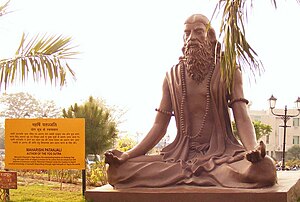
Back অষ্টাঙ্গ যোগ Bengali/Bangla Ashtanga (wyth cangen ioga) Welsh Astanga yoga Spanish अष्टांग योग Hindi Աշտանգա յոգա Armenian ಅಷ್ಟಾಂಗ ಯೋಗ Kannada अष्टांग योग Marathi अष्टाङ्गयोग Nepali अष्टाङ्गयोगः Sanskrit பதஞ்சலியின் அட்டாங்க யோகம் Tamil

Ashtanga yoga (Sanskrit: अष्टाङ्गयोग, romanized: aṣṭāṅgayoga[1], "the eight limbs of yoga") is Patanjali's classification of classical yoga, as set out in his Yoga Sutras. He defined the eight limbs as yamas (abstinences), niyama (observances), asana (posture), pranayama (breathing), pratyahara (withdrawal), dharana (concentration), dhyana (meditation) and samadhi (absorption).
The eight limbs form a sequence from the outer to the inner. The posture, asana, must be steady and comfortable for a long time, in order for the yogi to practice the limbs from pranayama until samadhi. The main aim is kaivalya, discernment of Puruṣa, the witness-conscious, as separate from Prakṛti, the cognitive apparatus, and disentanglement of Puruṣa from its muddled defilements.
- ^ Huet, Gérard. "Sanskrit Heritage Dictionary". sanskrit.inria.fr. Retrieved 2020-08-31.
© MMXXIII Rich X Search. We shall prevail. All rights reserved. Rich X Search